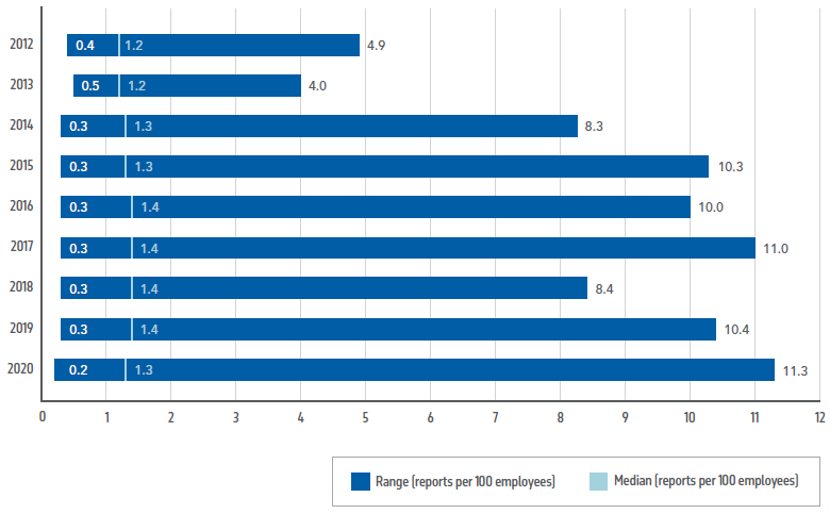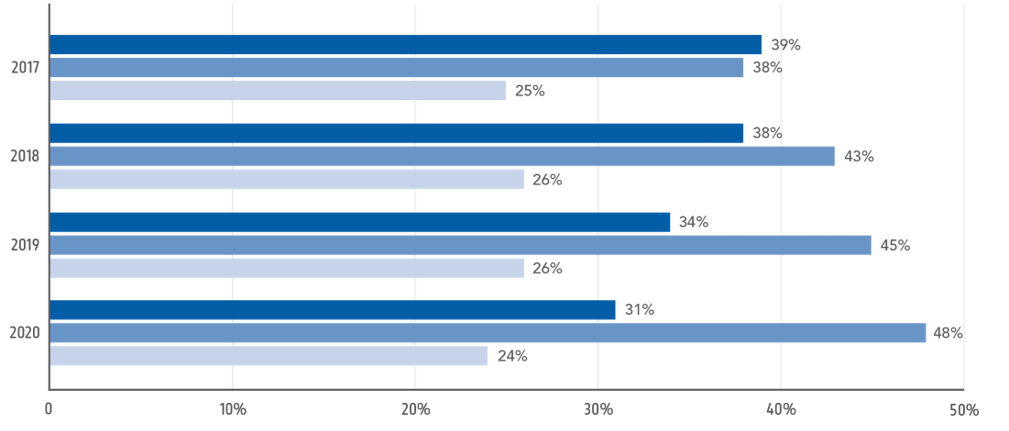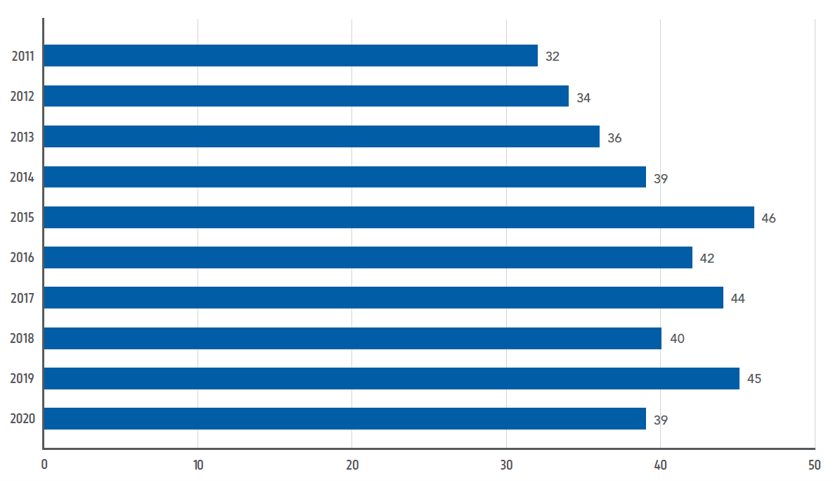This week, NAVEX Global released its 2021 Incident Management Benchmark Report. The analysis, which tracked and analyzed corporate compliance trends based on data from more than 1.3 million global incident management reports from over 54 million employees in 2020, validated what many compliance professionals had long suspected – the impact of the events of the past year on workplace culture will be felt for years to come.
The rapidly-maturing risk and compliance discipline was tested in 2020. Many compliance programs stepped up to the challenge with rapid response reporting.
To say 2020 was disruptive is an exercise in understatement. From the COVID-19 pandemic to the widespread protests for social justice, the past year marked an epoch in the popular consciousness. This new awareness will continue to serve as a catalyst for institution-altering change in 2021 and beyond.
These events also offer a unique challenge to organizations seeking to understand and interpret that change, particularly within the framework of an annual benchmark. In a year when everything was different, how can we separate the signal from the noise? What was unique to 2020, and what will inform the future?
This year, NAVEX Global has embraced the fact that our findings can only be understood within the context of 2020. Thus, you will see several new metrics that examine key measures on a month-to-month basis and map keyword reporting to world events.
Our analysis also incorporated recent developments within the risk and compliance space, such as the 2020 update to the U.S. Department of Justice’s Evaluation of Corporate Compliance Programs, court decisions like Digital Realty v. Somers, and the SEC’s record year of reports and whistleblower payouts. Events like these had a profound impact on our industry, and provide context in understanding what 2020’s data can tell us about the years to come.
The resulting analysis reveals several key trends and findings. Some, such as increases in environment, health and safety reporting, were clearly the result of (or accelerated by) the pandemic. Others, like the decline in retaliation, harassment and discrimination reports, continued independently of (or despite) recent events.
Taken together, however, the results reinforce a common narrative for 2020 of growth, variation and volatility.
The rapidly-maturing risk and compliance discipline was tested in 2020. Many compliance programs stepped up to the challenge with rapid response reporting, especially as the pandemic took hold in March of 2020.
This complexity has also led to an increasing diversity in program outcomes. Report volume ranges expanded in 2020, while the distribution of anonymous reporting rates shifted away from the median and toward the edges. These shifts may have been triggered by this year’s anomalous events, but could have a lasting impact on the organizations affected.
We are also witnessing a shift in when, where and how reporters make allegations. The pandemic has accelerated the trend away from hotlines and toward web reporting. Of concern is the fact that the gap between incident occurrence and incident reporting dates has widened dramatically, increasing the potential for important activity to be missed by compliance functions. As we all know, an absence of reporting doesn’t mean employees aren’t seeing wrongdoing or talking about it; it means they aren’t talking about it to us.
With that said, here are some of the biggest findings to come out of this year’s incident management benchmark:
COVID-19 impacted the size and shape of reporting and investigation.
As expected, incident management data from 2020 looked very different from previous years (though not always in ways we had anticipated). Key findings include:
- Report volumes decreased. For the first time in the history of our annual benchmark, the median number of reports declined, dropping from 1.4 reports per 100 employees (where it has been since 2016) to 1.3 in 2020. A month-to-month analysis reveals the extent to which this decline was driven by COVID- related events. To date, report volumes have yet to return to their pre-COVID levels.
How Does Your Report Volume Compare?

- Environmental, health and safety (EHS) reporting spiked as shutdowns began. The COVID-19 pandemic didn’t just impact report volume; it also affected what kinds of reports were being made. EHS reporting jumped from 10% of overall reports at the start of the year to 21% in March when shutdowns began. EHS reporting remains elevated, accounting for 17% of all reporting in December.
- Business integrity reports also rose in response to COVID-19. By the summer of 2020, Governments, NGOs and academics began to raise concerns about the potential for fraud, waste and abuse arising from COVID-19 responses. Our reporting data reinforces this analysis. As EHS reporting declined, business integrity reports rose considerably, with claims jumping by 39% between July and September. Further study by industry indicates the rise may be particularly connected to healthcare billing and coding (or miscoding) during the pandemic.
- Financial and misuse reporting increased in the arts and entertainment industry. In 2020, businesses in the “arts, entertainment and recreation” industries generated the highest median report rates for both categories. This shift may be attributable to the pandemic’s considerable economic impact on this sector, which in turn generated new levels of scrutiny of how resources were being utilized.
- Incident reporting tracked closely to real-world events and trends. This year, NAVEX Global tracked reporting related to specific topics, including COVID-19 and work from home. The results demonstrate that employees were actively using their incident management systems in response to events (including COVID-related deaths).
Recent events accelerated some trends (and failed to reverse others).
Many of COVID-19’s effects on incident management will likely have limited long-term impact on overall reporting. However, some previously identified long- term trends saw their growth accelerated by the crisis. Moreover, other long-term trends persisted despite the year’s events – demonstrating the nature of their underlying causes. Key findings include:
- Online reporting continues to accelerate. For the past several years, we’ve seen a steady increase in web submissions. In 2020, the massive shift to work-from-home continued that trend with online reporting reaching a median of 48% – a 26% increase from 2017. If current trends persist, it is likely that 2021 will mark a major turning point, with a majority of businesses finally receiving the majority of their reports online.
Median Reporting Rate by Intake Method Shows Continued Web Growth

- Telephony reporting continues to decline. With the increase in online reporting, there was a corresponding shift away from telephony. In 2020, the median percentage of telephone reports fell to 31% – their lowest levels yet.
- Anonymous reporting is slowly declining. Over the past decade we have seen a slow steady decline in anonymous reporting rate. In recent years, that trend had somewhat reversed. This year, however, anonymous reporting returned to its slow downward trajectory, declining to 58%. Moreover, there are indications that the trend away from anonymous reporting occurred despite recent events, rather than because of them.
Compliance met the incident management challenges of 2020 (mostly).
The past year posed a unique set of challenges for organizations and risk and compliance programs on many fronts – including incident management. Specifically, would the ability to accurately capture and investigate allegations be negatively impacted? The data suggests that, on the whole, compliance functions were able to overcome these challenges. Key findings include:
- Case closure times decreased. One of the biggest concerns about the work-from-home transition was whether it would negatively impact the amount of time required to close a case. The evidence indicates the opposite was true; median case closure times actually dropped to from 45 to 39 days – the lowest level since 2014. The most dramatic declines occurred in the environment, health and safety cases.
Median Case Closure Time In Days Improved Despite Remote Investigations

- Substantiation rates held. With a decline in case closure time, we would be concerned if there was also a decline in case substantiation rates indicating an inability to investigate the matter. This year’s data shows no meaningful drop in organizations’ ability to substantiate allegations. However, one notable substantiation trend was identified – a reduction in substantiation of anonymous reports.
Only time will tell which of these findings are oddities driven by proximate events, and which prove enduring. That said, this data suggests compliance professionals may need to:
- Anticipate an increase in reporting volumes as the pandemic recedes.
- Increase the capabilities and awareness of their online reporting functions.
- Encourage the early reporting of concerns (especially with respect to accounting, auditing and fraud).
Taking these steps will help compliance functions respond to the changes that have occurred and prepare for those to come.

